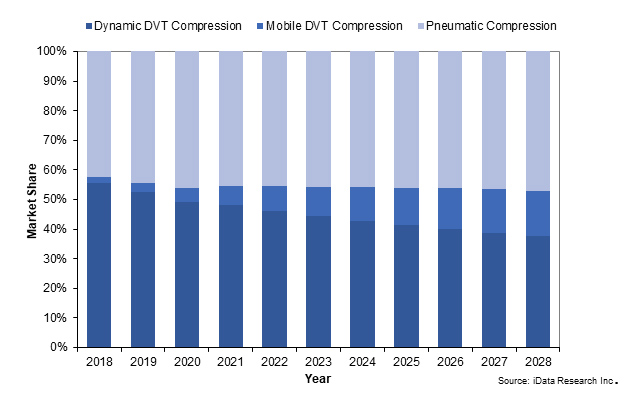Market Research: Demand For Dynamic Compression Devices Shifts Among Types
By Kamran Zamanian, Ph.D., iData Research Inc.
 The administration of pressure through a sleeve system, known as compression therapy, has been traditionally used to treat a variety of medical conditions such as lymphedema, edema, venous stasis ulcers, and diabetic foot ulcers. Dynamic compression therapy uses a mechanical pump to fill a wrap or sleeve with air. By squeezing the appendage, fluid and blood are pushed back to the body.
The administration of pressure through a sleeve system, known as compression therapy, has been traditionally used to treat a variety of medical conditions such as lymphedema, edema, venous stasis ulcers, and diabetic foot ulcers. Dynamic compression therapy uses a mechanical pump to fill a wrap or sleeve with air. By squeezing the appendage, fluid and blood are pushed back to the body.
One application of dynamic compression therapy is in the treatment of deep vein thrombosis (DVT). In this case, there are traditional dynamic DVT prevention devices, mobile DVT prevention devices, and pneumatic compression devices. Generally, pneumatic compression devices are used in patients with compromised circulatory systems to stimulate an improved flow of lymph and blood in the body. The market has been driven by the aging population and increasing rates of obesity found in the U.S., as well as the strong risk factors associated with diabetes and poor circulation. The more recent driver of sales for these devices has been general movement away from hospital-based care across the healthcare industry. Improved technology in the space has overcome the therapeutic barriers of compression devices. While these devices have a high up-front cost, they are clinically proven to be effective and can empower patients to self-manage their conditions in the home setting, which can often lead to improved outcomes and quality of life.
In addition to the traditional avenues of treatment, there has been an increase in the marketing of pneumatic compression devices as a form of recovery in high-level athletes. Contrary to the initial user base of pneumatic compression devices, these athletes have a healthy circulatory system and are applying these devices to reduce water retention and muscle soreness.
The Rise Of The Mobile Compression Market
Traditionally confined to the halls of hospitals and healthcare facilities in the last decade, there has been a distinct shift from hospitals to the home space for the dynamic compression market. In the last few years there has been a general trend for the healthcare sector to shift into alternate care spaces, which is in part a result of product improvements in the industry. This has been seen in the dynamic compression market through the high levels of growth present in the mobile deep vein thrombosis (DVT) prevention segment, for example.
Since the incorporation of dynamic compression devices into sleeves, the demand in this market has skyrocketed. Among the challenges of the current COVID-19 pandemic has been a nationwide chip shortage. The market conditions created in this time have resulted in backorders and other hindrances when it comes to manufacturers providing products to their clients. This has allowed new innovative products to enter the market to fill the vacancies caused by these supply chain issues. The corresponding rise in market competitors is expected to drive market growth with further penetration and use.

The Adoption Of Pneumatic Compression In The Fitness Market
Beyond the increases in portability of dynamic compression devices, the market is also being driven by an increase in usage. The overall wellness and fitness market is currently seeing 5-10% growth1 globally. This growth is being experienced in the U.S. market as it shifts away from a model of exercise and nutrition to a more holistic view of physical health, mental health, and appearance. Part of this process has been an increased emphasis on recovery. The science of recovery is complicated and means different things to many athletes who often follow their own regiment or ritual. Part of the success of pneumatic compression devices is the increased adoption through top athletes at the highest echelon of professional sports in the United States. The pairing of high disposable income and social presence has allowed for additional brand placement and marketing for competitors in this market. While the science behind pneumatic compression in people with healthy lymphatic systems is largely untested, its use and accreditation by multibillion-dollar industries such as the NBA validates the products in the eyes of potential clients. While these devices are not eligible for reimbursement, developed markets with disposable income are constantly looking for marginal gains in the training process, and this has been identified by market competitors.
Dynamic Compression In The Home And Fitness Industry
As the applications of compression change, there has been an increase in the demand for these devices, along with a decrease in the demand for traditional devices. In the coming years, the market is expected to see an increase in the use of mobile treatment, such as the aforementioned mobile DVT prevention devices. However, these mobile devices are not expected to simply cannibalize the existing market since mobile compression fills a market vacancy that has historically been inaccessible as a form of treatment. That is, prior to adoption of more mobile devices, there was a potential patient population that simply wasn’t being treated due to the lack of devices suitable for home care. Factoring in the additional revenue generated by non-traditional treatment areas, such as the fitness market, the overall dynamic compression market is set to continue overtaking traditional compression markets over the next decade. Although this is mirroring the general shift to alternate care facilities in the wound and tissue management market, the innovative designs and new technologies have acted as a catalyst in this market, laying the path to greater significance in the treatment of cancer patients, post-operation patients, and many more.
1Callaghan, Shaun, et al. “Feeling Good: The Future of the $1.5 Trillion Wellness Market.” McKinsey & Company, McKinsey & Company, 7 Oct. 2021, https://www.mckinsey.com/industries/consumer-packaged-goods/our-insights/feeling-good-the-future-of-the-1-5-trillion-wellness-market.
 About The Author
About The Author
Kamran Zamanian, Ph.D., is CEO and founding partner of iData Research. He has spent over 20 years working in the market research industry with a dedication to the study of medical devices used in the health of patients all over the globe.
